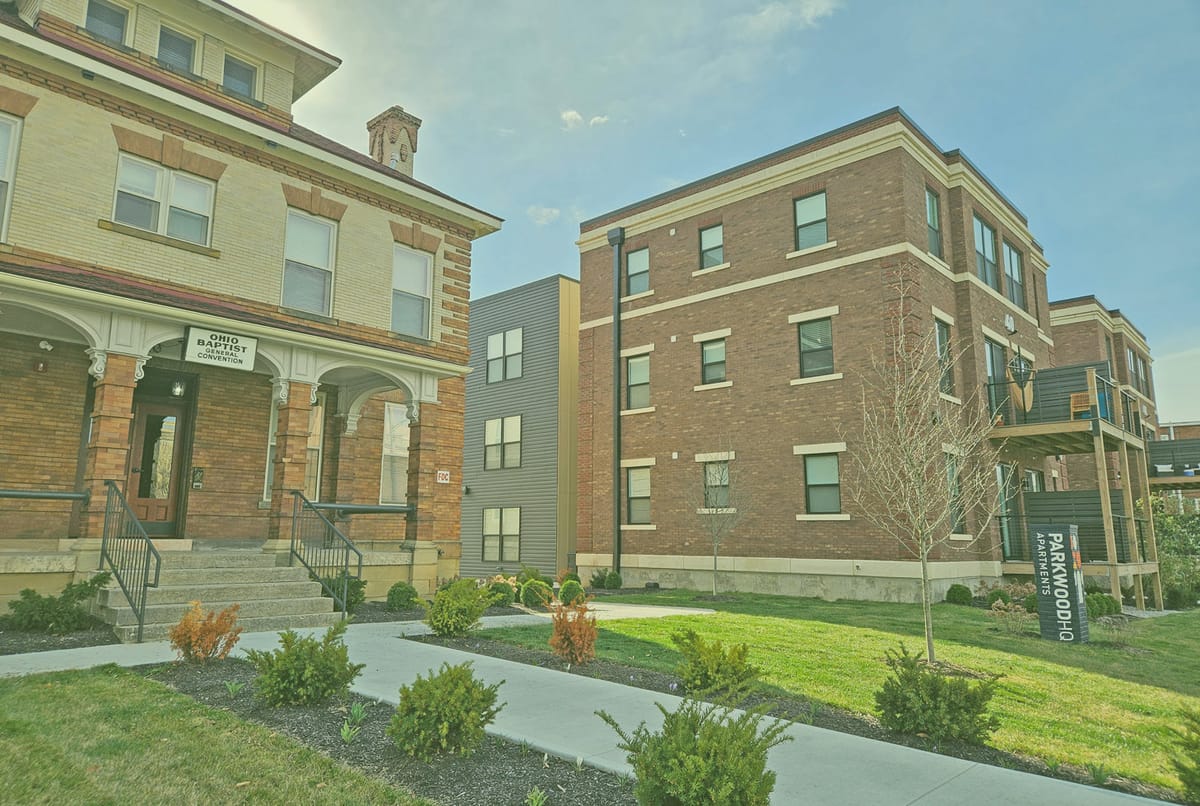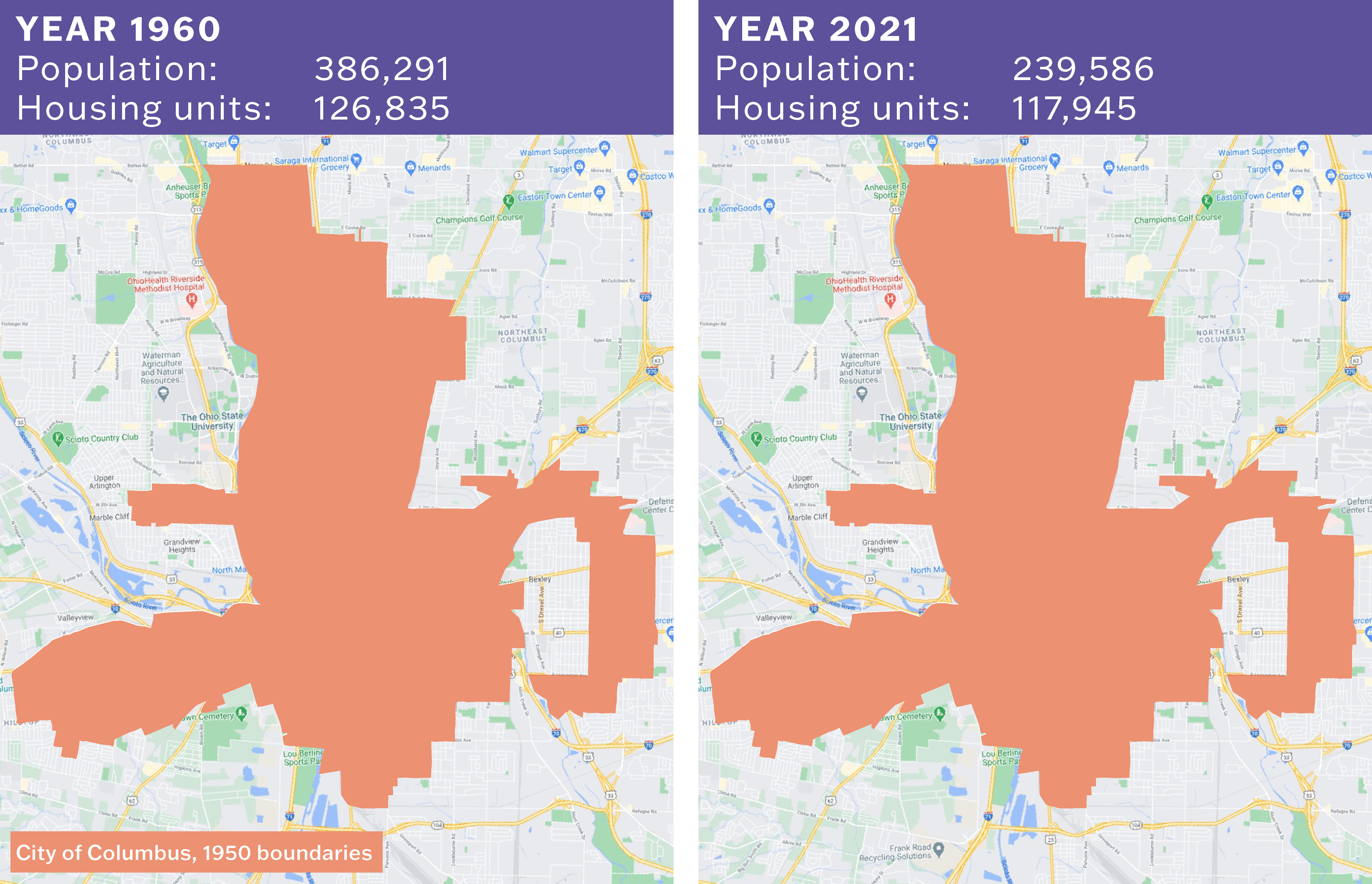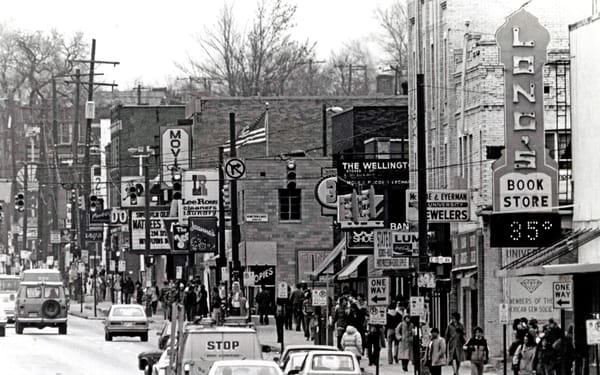💥 An overdue bulletin on housing and zoning
With punchy commentary and ample data ‼️

The zoning reform initiative of the City of Columbus is moving forward, with a goal of introducing suggested changes by early 2024.
Rather than a wholesale rezoning of the 290,000 parcels in the city, the first changes are poised to focus on 62 major corridors. Council may pass reforms by next summer, according to a recent Dispatch article that ruffled some feathers in the housing community. The article explicitly framed the zoning reform effort as an act that directly benefits developers rather than as a much-needed modernization initiative.
The comments included in the piece by opponents of zoning reform align with common gripes over chipping away at the irrational dominance of exclusionary single-family zoning, with an added dash of inaccurate and uncited statistics that The Dispatch chose to let fly. The article quotes a Clintonville resident and real estate broker—yes, a profession that would gain nothing from a boom in apartment construction—who believes “young people are tired of their dense urban living” in the Short North.
As a point of clarification, the Short North isn’t very dense.
For example, the census tract around Goodale Park has a population density of 11,417 people per square mile (ppsm). Even Clintonville, specifically the section bound by the river, High Street, Oakland Park Avenue, and Weber Road, has a population density of 8,337 ppsm and fewer housing units today than in 1960. For additional context, Over-the-Rhine in Cincinnati has a population density of 17,244 ppsm, Lakewood has figures 10-15,000 ppsm, and Pittsburgh has many neighborhoods between 15,000 and 20,000 ppsm (and even higher)!
The same real estate broker said "not everyone wants to live in an apartment forever.” Fine, but this is a non sequitur. No one is forcing people to live in an apartment forever, other than a supply-constrained housing market exacerbated by single-family zoning. Showcasing her business prowess, the broker claims “what the city needs is more single-family homes.” That’s more opportunity for non-negotiable real estate agent commissions, which by the way have been criticized as a form of industry collusion and brought to suit as an antitrust violation in the U.S. and Canada.
When people say we need more single-family homes, the spatial and population math just doesn’t compute.
Where in the City of Columbus corporation boundary would building new single-family homes have absorbed the 46,000 new residents who moved here between 2017 and 2021? The city’s current zoning map offers “nearly 50 square miles more single-family than multifamily zoning,” demonstrating how *attainable housing* is effectively prohibited by these antiquated rules.
There are 8,890 fewer housing units in the historic 1950 city boundaries today than in 1960.

This is a pretty astonishing piece of data. In urban Columbus, there are considerably fewer homes than there were 60 years ago. And 146,705 fewer people. When people claim we don’t need more housing or that their neighborhoods are already crowded, it is germane to remind everyone that our city is a hollowed-out shell of its former vitality. We have plenty of space to welcome new neighbors.
Density in the regional context
These conversations aren’t just happening in relation to the City of Columbus’ zoning reform initiative. Jurisdictions throughout Central Ohio are seeing new developments that allow people the choice of living in traditional walkable, mixed-use communities offering residential, office, and retail opportunities. Hilliard recently completed a new comprehensive plan allowing for modest density to give people housing options as they move through different life stages. Similarly, The New Albany Company is pursuing a mixed-use district with higher-density living options—unsurprisingly this multifamily housing would be within the Johnstown-Monroe School District, not New Albany-Plain Local. Bridge Park in Dublin continues to mature into a mixed-use destination unique in the region.
Upper Arlington has experience with densifying at Kingsdale and Lane Avenue, but the Golden Bear Center (at Fishinger and Riverside Drive) is the next node for denser mixed-use development (🐻 bearing a shocking resemblance to Bridge Park) that could offer unparalleled access to the City of Columbus parkland along the Scioto River. Likewise, Gahanna’s Creekside development and Whitehall’s impressive development effort all point toward the desire for traditional neighborhoods that offer residents the option to remain in their communities as their housing needs evolve.
Clearly, suburban jurisdictions see the value in compact redevelopment. What some suburban jurisdictions don’t feel, however, is any responsibility to provide housing for different income levels. They’re perfectly happy letting the City of Columbus handle that.
What can you do to get involved? Keep an eye out for future public engagement opportunities with the ‘Zone In’ initiative, and make sure you’re on their email list.
In the meantime, the ‘Zone In’ Columbus team will be attending two upcoming events if you’d like to stop by, learn more, and share your opinions on housing reform in the city.
📚 The Book Beat

According to Nolan Gray, arbitrary zoning codes are stifling both economic growth and personal opportunity.
Gray, M. Nolan (2022). Arbitrary Lines: How zoning broke the American city and how to fix it. Island Press.
This recent book lays out the nefarious origins of zoning, linking its enthusiastic adoption with the (generally speaking) WASP-led (White Anglo-Saxon Protestant) municipal reform movements of the Progressive Era. By doing so, author Nolan Gray claims that one central rationale for adopting zoning was racial segregation. Of course there are numerous examples of explicit racial zoning (in particular Baltimore), but by the 1920s zoning was being adopted for—purportedly—the separation of land uses.
However, with the Great Migration (the movement of African Americans from the rural south to northern cities) beginning around 1910 and the peak year of European immigration being 1907, it appears probable that the rush to institute zoning ordinances was influenced by the overall socio-demographic developments of the 1910s—the perception of growing diversity as a threat the status quo of “native” white dominance, for example.
Gray also argues that zoning promotes sprawl. While overwhelmingly true, zoning codes can just as easily be re-written to incentivize, promote, and even require dense development patterns. Instead, Gray advocates for abolishing one of the most powerful tools the public sector has to influence the form of private development. Just as zoning has required minimum parking, it can be retooled to require zero or impose parking maximums. “We can’t tinker our way out of this one,” he writes. “The longer-term objective must be zoning abolition” (Gray, 2022, p. 127).
Houston, a major city without zoning, is discussed as a place thriving without the burden of public zoning. But land use disputes rage there nonetheless, and it’s still one of the most segregated large cities, with a rating of “High Segregation” by the Othering & Belonging Institute at UC Berkeley. On the Brookings Metropolitan Policy Program’s Metro Monitor platform, Houston also ranks middle-of-the-road or low on indicators of racial inclusion and employment. If the lack of zoning in Houston is working, it may be working better for affluent communities with the infrastructure to institute, manage, enforce, and arbitrate deed restrictions. Furthermore, Texas has an abundance of cheap land, streamlined permitting processes for housing construction, a low cost of living, and no income tax. There are many other factors—outside of a lack of zoning—that contribute to lower housing costs in Houston.
Arbitrary Lines does important work to illuminate the genesis, rationale, and origins of American zoning. For that, the book is emphatically praised and recommended as essential reading. But take caution that abolishing one of the most powerful tools of public governance to manage the self-interested impulses of private property owners would create a power vacuum too strong and unpredictable to risk. Zoning can absolutely be re-tooled to achieve equity gains and should certainly not be dismantled.
How the pro-housing and pro-labor movements are interrelated
This piece (shown below) is making the rounds in pro-housing circles, and for good reason. A lack of housing supply benefits particular groups, foremost landlords and current property owners. Restraints on housing construction (like antiquated zoning) are one way to ensure continued asset growth for these groups.
A lack of supply and low vacancy rates also ensure that renters have little choice of where to live and have to accept the terms demanded by landlords—price, location, condition of units, security deposit demands, pet policies, and potentially discriminatory and predatory behaviors. In a community of abundant housing, tenants would have more leverage to negotiate better rental circumstances by exercising the power of, well, leaving for another apartment.
“In vast swaths of America, including most of its vibrant major cities, the single most overwhelming economic issue that is squeezing workers is the cost of housing.”
“The only winners in this situation are the landlords (and existing homeowners) who own the existing housing supply, who are free to continue raising their prices, because the housing shortage means that people don’t have other choices.”
The corollary between worker wages and housing costs is long-established. But in times and locations where housing costs are particularly intense, the landlords begin to reap disproportionate profit from their exclusive control of shelter. At the same time, employers suffer due to the negative effects of housing cost burden and locational inefficiencies experienced by their employees. If housing costs are so extreme that employees can’t afford to reside near firms, the increase in wages offered by employers are essentially transferred to landlords.
Hamilton Nolan asks the provocative question: “What good is a higher wage, if all of it goes directly to the landlord?”
🗞️ Recent Housing News + Discussions 🏘
Local
- Letters to the editor: Supporting the city’s zoning update (scroll down)
10 September 2023, Columbus Dispatch - Opinion: Clintonville NIMBYs Couldn’t be More Wrong on Zoning Updates
9 September 2023, Columbus Underground - Columbus overhauling more than 70-year-old zoning code
5 September 2023, Columbus Dispatch - United Way Sells Columbus Headquarters to Make Way for Mixed-Use Project
30 August 2023, Affordable Housing Finance - Central Ohio home sales cooled slightly in July as prices stopped setting records
22 August 2023, Columbus Business First - Affordable housing complex planned near Columbus College of Art & Design
17 August 2023, Columbus Dispatch - Central Ohio faces housing, transportation issues as region continues to grow
16 August 2023, WBNS - How Columbus is fighting the housing crisis
15 August 2023, NBC4i WCMH - $50 million dedicated to expanding affordable housing in Linden
15 August 2023, Columbus Dispatch - First Community Land Trust Apartments Bring More Affordable Housing to Franklinton
8 August 2023, Columbus Underground - Sustainable, inclusive housing growth: A case study on Columbus, Ohio
19 July 2023, McKinsey & Company
National
- On Gentrification, We Don’t Know What We’re Talking About
5 September 2023, Kate Wagner, The Nation - This Is Public Housing. Just Don’t Call It That.
25 August 2023, The New York Times - NYC Lost 100K Homes in Apartment-to-House Conversions
24 August 2023, The City - How housing activists and unions found common ground in California
21 August 2023, Vox - New York Plans to Convert Parts of Midtown Manhattan to Housing
17 August 2023, The New York Times - Houses Are Still Big. Prices Are Much Bigger.
17 August 2023, The New York Times - U.S. Mortgage Rates Jump to Highest Level Since 2002
17 August 2023, The New York Times - A Private Equity Firm Might Be Your Next Landlord
15 August 2023, The New York Times - Is It Possible to Buy a House in Your 20s? Yes, but Only With Some Help.
5 August 2023, The New York Times
Show neighbors your welcoming spirit!
Brighten up your yard or window with one of our colorful signs. Contact us to arrange a pick-up or delivery!






